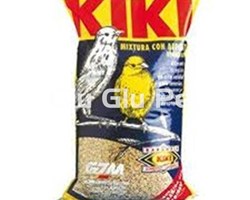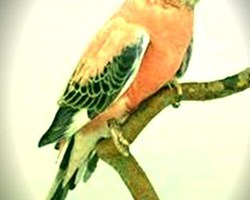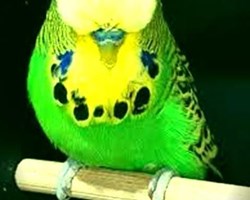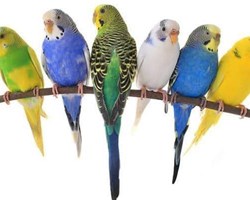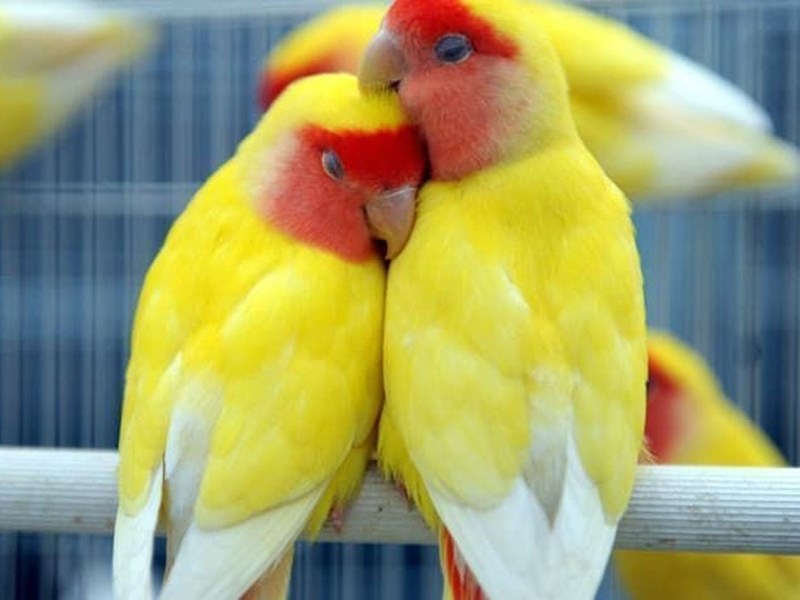
THE AGAPORNIS ARE THE KINGS OF SOCIAL NETWORKS:
They are the kings of social networks along with the nymphs.
You can see them on Twitter, in memes, on TitkTok and they even have their own Instagram accounts.
Rare is the platform where there is no post about them.
CURIOSITIES OF THE AGAPORNIS:
These little guys of just 15 cm have stolen the hearts of the public with their cheerful and loving character.
Its small size has not been an obstacle when it comes to making itself known to the whole world.
The lovebird was discovered in 1887 by Dr. Fischer in Africa.
Although it was discovered almost 150 years ago, it did not reach the European continent until the German zoologist Carl Hagenbeck brought some specimens in 1973.
Its name, lovebird, comes from the union of the Greek terms "agape", which means love or affection, and "ornis", which means bird.
That is why in English they are known as lovebirds and in Spanish they are also called love birds or inseparable.
WHY DO THEY CALL IT THE BIRD OF LOVE?
Because the lovebird is one of the most “loving” birds.
As with most birds, it is a monogamous species.
Once he finds his partner he never separates from her, if the partner dies, he will try to find another affinity with whom to share the rest of his life.
The lovebird is a love bird, also with its owner.
His cuddly character makes him very close to his owner.
It does not matter if you are alone or in a couple, it is normal for you to create a very special bond.
In addition, he loves to play with him, to be out of his cage and to be pampered by stroking his feathers.
Its affable character makes the lovebird also an easy bird to train.
He's very smart, but you'll need time to get him to do some tricks and exercises.
You can teach him to grab things with his claws, to spin around, to perch on your finger.
And taking his prizes from time to time.
The lovebird is very loving, but also very territorial.
They don't like strangers roaming their territory, and if they don't like another animal or someone they can be aggressive.
They really like water.
They love having a bathtub in their cage as much as they love sticking their heads under the faucet.
Dips are a must for them.
HOW IS A FEMALE LOVEGAM DIFFERENT FROM A MALE?
Both sexes are so alike that only a DNA test could tell you for sure if it's one or the other.
The lovebird is digodactyl: its lovebird claws are placed differently from those of other birds.
In his case, two fingers point forward while the other two point backwards.
The lovebird can have a wide variety of colors.
Although the best known are green, yellow and orange, there are also blue, white, purple or black.

TO KNOW EVERYTHING ABOUT THE AGAPORNIS YOU NEED TO KNOW HOW THEY LIVE IN FREEDOM:
Lovebirds are birds from the African continent and not from South America as many people think.
They are birds accustomed to dry and arid environments, and where food is not very abundant to say the least.
This type of bird belongs to the Psittaculidae family.
Lovebirds are also known in some countries as "inseparable birds", hence, instead of lovebirds they are called inseparable.
The name inseparable has been given to them because they are monogamous birds, they pair up and are already together forever, hence they have been given the affectionate name of inseparable birds.
With this inseparable thing there is a lot of street myth, that if you can't have them alone and things like that.
You can have a lovebird alone and there will be no problem.
VARIETIES OF THE AGAPORNIS:
THE AGAPORNIS PERSONATA:
The agapornis personata is unique and uncomplicated.
The agapornis personata is one of the most liked by people who are interested in this type of bird as pets, especially the blue agaporni personata.
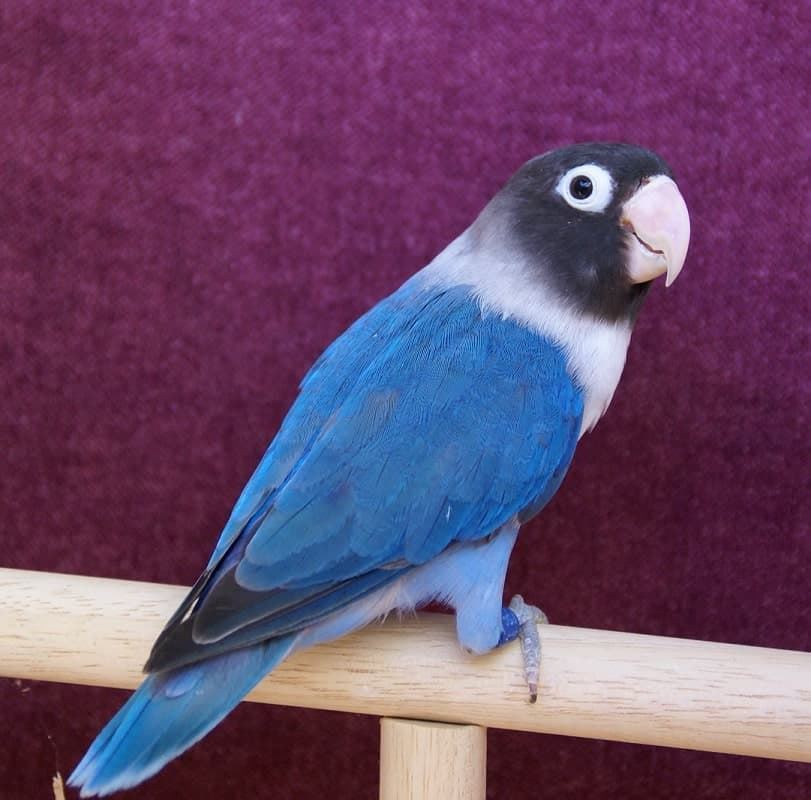
The agapornis personata is an ideal pet for the whole family and with which you will fully enjoy a agaporni personata.
These small birds are native to the African continent and have become the ideal and easily accessible pet for those who are looking for a small and easy-to-maintain parrot.
AGAPORNIS PERSONATA ANCESTRAL:
The ancestral type agapornis personata is unmistakable friends, since its head is completely black and its body is green.
This type of lovebird is a bit more skittish than the rest of the birds of its species.
Even if you raise him from a young age.
Although as in everything there are exceptions.
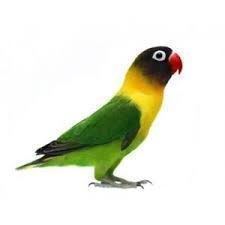
SOME CURIOSITIES OF THE AGAPORNIS PERSONATA:
Most come from the East African area. Hence why not worry so much about fruits and vegetables for this type of bird, since they come from dry and arid areas.
This animal is a very docile type of bird if it is mixed with other species or even with other types of different birds such as nymphs, parakeets, etc.
TYPES OF AGAPORNIS PERSONATA:
All the types and colors that you can find of agapornis personata:
In the types of personas, the most popular is the blue personata, which is basically the same as an ancestral one but we changed the green to blue and the yellow to white.
The blue personata is a beautiful bird, and much appreciated by fans.
Then we have the ancestral personata, and from there an infinity of varieties that are achieved through mutations of personata.
DIFFERENCES BETWEEN PERSONATA AND FISHER:
Although it is true that all types of lovebirds have a similar character, they are cheerful, it is also true that there are certain characteristic aspects that help us differentiate them.
The fischer's lovebird stands out for having a white eye ring that surrounds its eyes and it does not have feathers on that part of the face.
Also its plumage is intense green on the back, chest and wings.
On the other hand, the personata lovebird has other characteristics that make it different from the fischer, which I will tell you about below.
CHARACTERISTICS OF THE AGAPORNIS PERSONATA:
- It measures about 15 cm more or less long, from the beak to the tail of the agaponis.
- Something typical of this lovebird is its black head.
- Its chest and neck are yellow, ideally the bird seen from the front where the yellow color ends on its chest. Finish as linear as possible.
- The rest of the animal's color is green, and its tail may have a bluish hue.
- It has the white eye ring typical of this species.
- Its beak in the ancestral personata variety is red, but in other mutations of this type of bird it will be cream.
- This type of inseparable has gray legs, typical of parrots.
Apart from the ancestral type, another highly demanded one is the blue, or personata blue.
The blue one can be perfectly mixed with an ancestral green one.
The hatchlings will be 50% blue or green.
THE LUTINE LOVE LOVERS:
The lutino personata is a yellow bird, and it is one of the few that keep a red beak apart from the ancestral one.
The lutino is practically the same as the fischer lutino.
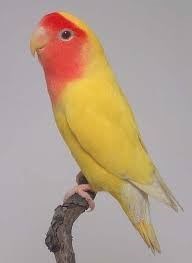
THE HARLEQUIN AGAPORNIS:
The harlequin lovebird is one of the mutations apart from the personata blue, most seen.
The difference with the ancestral is that it does not have a uniform green plumage, but rather has some small changes in color.
That's why they are called harlequin.
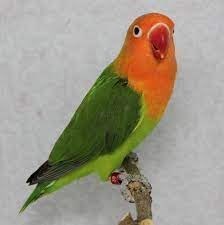
As for their character or personality in general, agapornis personata are very happy and playful animals.
The males are much more sociable with people than the females, who are more surly, although over the years they also become inseparable companions of their male.
There are usually some tense and high cries but they are not particularly annoying.
The song is very beautiful and they can imitate sounds and even in exceptional cases speak.
It is very difficult for them to imitate the human voice, that only happens with some specimens that have been trained since birth.
THE BEST CARE OF AGAPORNIS PERSONATA FOR ITS REPRODUCTION:
The care is more important in the breeding season, which is during the months of March and April until the months of June and August.
In the breeding season it is important that it is neither too hot nor too cold, about 25 degrees on average.
The female makes her small nest mainly in trees, in small crevices or in swallow nests.
The nest, as in any other type of bird, has a dome shape that is built with fine twigs and shredded bark, which the female carries in her beak, palm leaves, in short, whatever they have on hand.
It should be noted that they work as a team, although it should be noted that the female is much more hard-working than the male, transporting the twigs to the nest.
These birds are active and resistant birds.
These types of birds generally love to take baths in the water.
In colonies that is how they are more comfortable.
They are very easy birds to breed and maintain.
They can breed for almost the whole year if they are in optimal conditions.
For the breeding of these birds it is necessary to leave a palm tree within their reach so that they can make their nest.
Only 3 sets per year.
So that they can build the nest, which after shredding them they will transport between the feathers to the nest.
The laying of the female is usually between 3 and 6 eggs and they lay every other day.
The incubation period lasts approximately 21 days.
It is convenient to supply them with calcium and vitamins during breeding, otherwise the youngsters may be born with feather deficiency.
Apart from that the female suffers considerable wear.
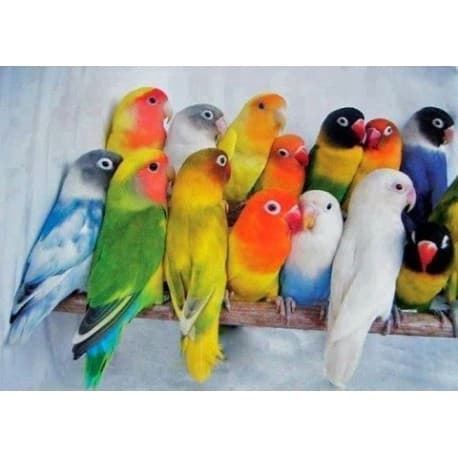
IT IS VERY IMPORTANT TO KNOW THE PERSONATA'S TEMPERAMENT AND PERSONALITY TO KNOW HOW TO TAKE CARE OF THEM WELL:
As for the temperament or character of the agapornis personata, the females are meaner than the males.
It is not to arrive and make a couple on the fly, it takes months for the female to accept the male, the female to the male.
And to get used to humans, up to years to have complete trust in its owner.
Remember that they are not dogs, they are birds and by pure instinct it will cost them a lot to have full confidence in you, be patient with your lovebird personata.
In captivity, this type of bird, which is what interests us, is convenient to leave leaves for them to bite and break, making strips and taking them to the nest.
They like music, so when the owner is away it is convenient to leave them music to get used to the words.
Some even dance to sounds they like.
They are very tender birds and an ideal companion to have as a pet.
Call him by his name, say easy words, etc… Maybe one day you get a surprise and he says a word to you, you never know.
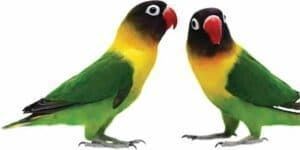
ADDITIONAL AND IMPORTANT INFORMATION ABOUT AGAPORNIS PERSONATA:
Do not make the big mistake of many people and do not let your animals loose with open windows.
Not to mention all the potential predators out there: cats, other birds, etc.
When they are not in the breeding season, they spend most of their time cleaning and grooming themselves, they are very presumptuous.
Like any psittacine and bird in general, they must live in pairs with other birds of the same species and opposite sex, or two males, never put two females in the same cage, because they are strong and territorial, the fight is guaranteed, Regardless of the relationship they have with the human owner, which will be more affectionate if the animal has been raised by hand from a chick, that is, if it is a Papillon lovebird.
THE ROSEICOLLIS AGAPORNIS:
The roseicollis lovebird has an approximate size of about 15 cm and is native to the African continent.
The ancestral type of agapornis roseicollis the color of the body is green.
They have a salmon pink head or there is also an orange face, or a peach face.
VARIETIES OF THE AGAPORNIS ROSEICOLLIS:
This type of lovebird roseicollis is the one that best gets used to humans.
They are easy to breed, there are many color mutations of agapornis roseicollis.
Even if you acquire an adult specimen of this bird, they easily adapt to living with a family, becoming very affectionate with their owners.
Never comparable to a papillero roseicollis lovebird, but they can be used to humans, becoming very tame. Of course, with patience and dedication.
As this bird, the roseicollis lovebird, is so friendly and affectionate, professional breeders prefer to breed specimens of other species such as the fischer or personata.
The roseicollis lovebirds of this breed, when mixed with other types of birds, become gulfs.
Their character changes radically and they are very territorial.
Especially when they are pairs, the female roseicollis lovebird is very territorial and defends her territory with a clean peck.
HOW TO RAISE A ROSEICOLLIS AGAPORNIS?
If we opt for an aviary or cage, we must remember not to put too many pairs of roseicollis lovebirds, otherwise we will have a problem with the female roseicollis fighting, they are very territorial.
The same happens with the nests, there must be more nests than pairs, and if possible they are all at the same height, so we will avoid messes, in case of having different species of lovebirds.
It is recommended that each of the lovebird species is in different aviaries, that is, roseicollis with roseicollis, personata with the persontas.
If the aviary is outside, it must have a shelter for cold and rainy days, where the nests and food must be.
Attentive, beware of possible predators outside, even if you are in the city.
If you decide to raise your roseicollis lovebirds in cages, you must have adequate measurements for the cage of our birds, which will be 60 x 40 x 40 cm, but remember that the larger it is, the better they will be.
During the breeding season, roseicollis lovebirds must have palm branches at their disposal so that the lovebirds can build their nests.
This material is easy to get in practically any country, it is the ideal, because they make band-aids with the palm tree and build the nest.
If you do not have access to the palm tree, in any pet store they sell material that is equally worth it.
Of course do not forget to put breeding paste, vitamins and very important calcium for your roseicollis lovebirds.
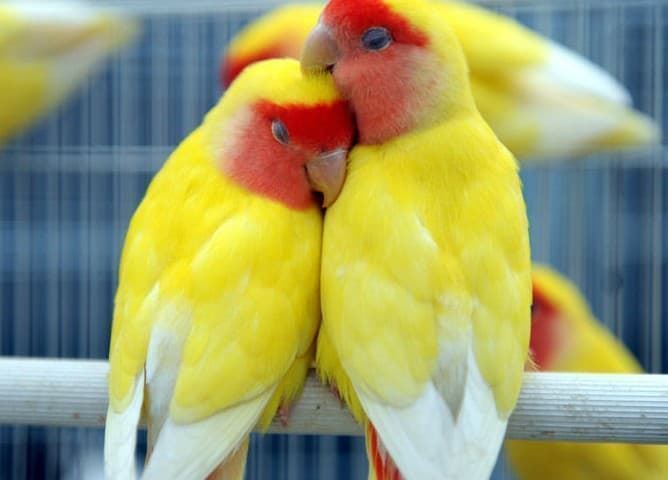
THE FISCHERI AGAPORNIS:
The fischeri lovebird is one of the smallest lovebirds.
This type of agapornis fischeri measures between 14 and 15 centimeters in length, a difference of 1 cm with other races of agaporni.
Its weight usually ranges between 45 and 58 grams.
Their red beak is what distinguishes them from other types of lovebirds.
The fisher lovebird is one of the most beautiful, since this type of lovebird has many colors.
GENERAL CHARACTERISTICS OF THE AGAPORNIS FISCHERI:
The front part of the body of the fischeri lovebird glows with color.
His chest, back and wings are green.
The neck of this lovebird is golden yellow.
As we go up towards the head it turns orange a little dark.
The beak is bright red, something very typical of this species of lovebird, and the upper part of the head is olive green.
The tail of this wonderful bird we will see, that in the upper part of its tail it has various violet or blue colored feathers.
The eyes are black and it has an eye ring, a white circle around them.
THE CHARACTER OF THE AGAPORNIS FISCHERI OR FISCHER:
In terms of character, the fischer lovebird stands out for being very sociable, just like the roseicollis lovebird.
They are also usually very attached to their partner or their master, taken out papilleros.
So much so that there are cases of specimens that have died after being separated or losing their partner of the opposite sex.
So that this does not happen, you have to quickly find another partner, and you will see that nothing happens and you recover from your loss.
THE BEHAVIOR OF THE INSEPARABLE FISCHERI:
This type of fischeri lovebird has a loud and sharp sound or song that can sometimes be a bit annoying.
But it's quick to get used to it.
When they fly freely, their flight is very fast when flying in a straight line and the sound of their wings beating is so energetic that it can be heard from the ground.
The Fischer's lovebird, like the agapornis personata, is a bird native to a small area of Africa, specifically to the southeast and south of Lake Victoria in northern Tanzania, central-eastern area of the African continent.
This area of the African continent has suffered a great drought for many years.
The lovebirds have migrated looking for better conditions.
Wetter to neighboring countries like Burundi and Rwanda.
THE HABITAT OF THE AGAPORNIS FISCHERI TO BE ABLE TO TAKE CARE OF IT THE BEST POSSIBLE:
The natural habitat of the fischeri lovebird is the trees that are available in their area, they generally like to live in colonies.
They like isolated areas, such as large plains.
The population of this type of lovebird is estimated at approximately 700,000 individuals.
There are very few birds of this breed outside protected areas.
The illegal trade in these birds has done a lot of damage to their natural habitat.
THE BEST NUTRITION OF THE AGAPORNIS FISCHERI OR FISCHER:
In freedom or in the wild, they feed on a wide variety of fruits and seeds.
On some occasions, if a large number of specimens gather, as with the roseicollis lovebirds or the personal lovebirds, they can be real pests for farmers, since they can devour entire crops of millet or corn in a short time, they eat their crops like the corn and millet.
In captivity, adults eat sunflower, herb seeds, millet, necessarily various fruits, especially apples) without forgetting carrots.
A good recommendation is also to buy a mixture of seeds.
At the time of nesting, we will add an egg-based bait to the menu.
Normally, lovebirds or inseparable lovebirds eat a mixture of seeds made specifically for them, which is called a mixture for lovebirds, which is made up of the following types of seeds:
- 45% canary seed.
- 15% yellow millet.
- 12% white millet.
- 9% safflower.
- 5% wheat.
- 3% hemp seed.
- 2% peeled oats.
- 8% red millet.
- 4% flaxseed.
- 2% bold.
It does not have to be exactly like that, each manufacturer adjusts the percentages according to their studies and experiences.
The mixture or mixture of seeds may or may not have seeds.
Ideally, the less the better since they are a food that although they love it, it is very fatty.
It is almost a treat for them just like for parrots, so moderation with the pipes that you give to our little friends the lovebirds.
You can give them extruded feed, which is made specifically for them.
This extruded feed for lovebirds or inseparable lovebirds comes very complete, with everything you need to feed the animal. especially for them.
It is very likely that at first they will not eat it or play with it by throwing it, but over time they will accept it as just another meal.
The food for lovebirds, the first thing you will be surprised by is the pleasant smell it gives, the ideal food for your lovebirds, logically alternating from time to time with other foods such as seeds, fruits, vegetables, etc.
The advantages that I see in the feed is that it is not thrown away as happens with the seeds that are eaten half and the rest ends up on the ground. Another advantage is that it is perfectly formulated by veterinarians and contains everything they need.
Panizo feeds, but it should not be abused.
Remember that panizo is still a treat for them, it is food, yes, but in its proper measure.
Try to have healthy, large and strong birds to feed them as varied as possible.
You can alternate the seeds, with feed, also fruits and vegetables, in short, there are a lot of combinations that you can make, but as long as your inseparable ones let you.
With the fruit and vegetables for the lovebirds, they like lettuce, red pepper, apple, pear and well, each inseparable bird is a world, you go giving him something to try and he will tell you what he likes and what he doesn't like.
- KIKI COTORRAS, AGAPORNIS AND NYMPHS 5Kg.
- Mixture for nymphs and lovebirds Shambi 1Kg.
- PANIZO.
- VIT PRO FOR NYMPHS AND AGAPORNIS 1kg.
There are prohibited foods that can be deadly for our pets.
Among them is:
- The avocado.
- Raw potatoes.
- Parsley.
- Coffee.
- Soft drinks or alcohol.
- No milk or milk products.
You can also buy vitamins at Glu Glu Pet, to make sure that it has the indicated vitamins, especially during the breeding or moulting season, when this type of bird has a lot of wear and tear.
If you want some advice, buy them liquid to put in the water, since that way you make sure that they drink them.
Make sure you read the directions and don't overdo it, as too many vitamins are just as bad as too little.
We also have the breeding paste, not to be confused with the porridge for the papilleros lovebirds, which has nothing to do with it.
This breeding paste is the typical yellow paste with little black things in bags that you may have seen, at Glu Glu Pet we have different brands.
They are made from eggs and bakery products.
It is good to get them used to this food, apart from because it is rich in protein, it will be an essential food during the breeding season.
That it is good in the breeding season does not mean that you should give it to it only in that season.
Ideally, you get them used to it and you can give it that breeding paste from time to time, as one more food.
Remember the secret to having large and healthy lovebirds is food, and the more varied it is, the better for them.
Logically, each lovebird is different and what some like, others will not like, but it varies, patiently get them used to eating everything.
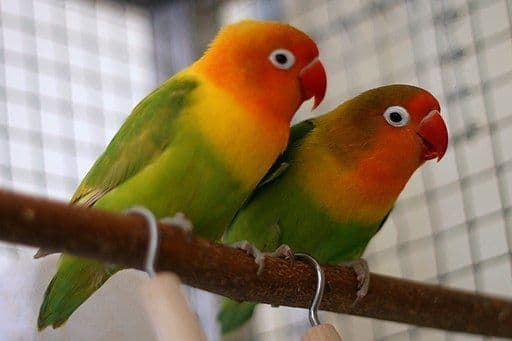
THE BEST CAGE FOR YOUR LOVEBIRDS:
The same your idea is to have only one, nothing happens, better for the inseparable, more space will have to move and exercise.
You should also keep in mind that we will put some toys inside and what it does is take away space for the lovebird inside the cage.
The shape that the cages for lovebirds should have is more important than you can imagine.
Never buy a round cage for your pet, and this has an explanation.
Being round, the animal does not have any point of reference, which will cause stress and fear and that is not good for these birds.
The best option you can take is to buy a rectangular lovebird cage with horizontal bars.
Well, simply because that way they can help themselves with their beak and legs to climb, which is something that these birds like very much.
WHAT TOYS TO PUT IN THE CAGE OF OUR AGAPORNIS?
In the cage of our lovebird we will put perches and toys, which can be the plastic ones that the cage brings.
At Glu Glu Pet we advise you to opt for wooden perches, since this way they can file their beak, nails or scratch themselves.
But it's also okay if you want to use the plastic ones for whatever reason.
You can buy some special hangers that are like sandpaper, with that type of additional hanger they could also be filed and scratched without any problems.
Also the hangers of natural branches, of fruit trees better.
The good thing about these branches is that they are not harmful to the birds, in addition to being able to jump from one branch to another and thus get a little exercise in the cage that will always come in handy.
HOW TO CLEAN THE CAGE AND HYGIENE OF OUR AGAPORNIS?
To begin with, lovebirds are very clean birds, and you can see how they spend the day grooming their wings, or taking baths.
At Glu Glu Pet we advise you to clean the cage of our lovebirds at least once a week.
We must disinfect it with bleach, for example, including the bars, hangers, etc... It is very important that you make an extra effort for the lower plastic tray, where the faeces fall, you have to clean it thoroughly because it is a tremendous source of infection.
Of course, remember to rinse your inseparable's cage thoroughly to avoid traces of bleach or whatever you used to clean the cage.
Use as much water as necessary to rinse it well.
Put a bathtub, you will see that he has a good time taking a good bath, especially in summer. Important, when the water is only for bathing, remove it the same day, because it will surely get dirty and your lovebirds may drink from it.
WHERE TO PUT THE CAGE OF THE AGAPORNIS?
You must be very careful with air currents, since they are charged at the moment to this type of bird. Ideally, at first you put him in your room so that he is calm and adapts to you and then you can consider if you want, put the cage in the living room or dining room, as long as there are no drafts.
You can put the cage in a window that is not usually open, so that it gets the sun in the morning, on a terrace that is well protected from currents, but also from predators, do not forget that.
As a recommendation, look for a place where the cage is attached to the wall, we will give you security.
Of course, the chosen place must be free of smoke and lights that hit it directly.

